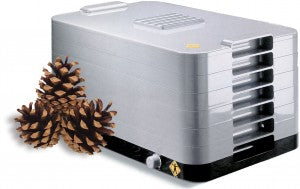When it comes to food storage, there are few things more satisfying than “putting up” your own food. Drying, or dehydrating, homegrown produce is one of the traditional ways of food preservation. This process involves removing moisture from food, while exposing it to temperature increases and moving air. Dried fruits provide an inexpensive and sweet alternative to sugary store-bought foods. Fruit leathers and jerky are two examples of snack replacements that you can produce at home for mere pennies.

The three primary ways of home drying food today are sun-drying, oven-drying, and using a food dehydrator.
Sun drying is ideal for fruits such as apricots, peaches, grapes, and figs, although there are other foods suitable for this method. Sun-drying requires a number of hot (85 degrees or higher) days with relatively low humidity. Spread thin pieces of fruit evenly across a shallow pan and cover with cheesecloth to keep the food safe from bugs. Putting boxes in the back seat of a car and laying the tray on top, with full exposure to the sun through the back windshield is a creative and easy way to dry food. Others have used sunny porches, balconies, and even flat roofs to dry their food.
Oven drying involves drying food at temperatures between 130 and 150 degrees. (Some older ovens may not have temperature settings this low). As in sun-drying, distribute pieces of food in a shallow pan or dish. You may want to check the food periodically for adequate dehydration. If the temperature is too low or the humidity too high when sun or oven-drying, the food may dry too slowly or even spoil. When the temperature is too high it could cook the food and make it hard on the outside, while leaving the inside moist and vulnerable to molding or other forms of spoilage from microorganisms.
Food Dehydrator Commercial food dehydrators offer the most controlled drying environment. They provide a constant ideal temperature combined with heated air that circulates via a blower or fan. Most food dehydrators also offer liners and trays for dehydrating fruit leather and small, sticky foods. Fruits, vegetables, and meats can dry while you are away at work, asleep, or doing your household chores with minimal worry or fuss.

After drying the food, cool it to room temperature and loosely package in plastic bags, hard plastic containers, or glass jars. For longer-term preservation, pack in airtight containers. Foods that you dehydrate yourself are not only great for snacks at home but are useful when camping or backpacking since they do not require refrigeration. There are many good books on the market that specifically describe how to dry fruits, vegetables, and meats with delicious recipes included.




3 comments
Bruce
I have been dehydrating this spring. Found a wealth of FREE information on the internet… Google it ;)
beprepared
Hi Rick,
We sell a book called Making and Using Dried Foods which gives a pretty good overview and how to get started with dehydrating. I just went down to the warehouse and checked it out, and it gives some really good tips and things to consider that you might not have being a first time dehydrator. Here’s a link to the book to check it out http://beprepared.com/making-using-dried-foods.html?&sc=BLOG&oc=BP0001B1358 Also, we recently made some jerky and tomato sauce leathers here using the Excalibur dehydrator. You can check out the excalibur here:http://beprepared.com/excalibur-deluxe-9-tray-dehydrator-black.html?&sc=BLOG&oc=BP0001B1359. It’s a very sturdy and durable dehydrator. I was surprised to find that there is a VERY informative guide that the people who make the Excalibur dehydrator make. The book is called preserve it Naturally you can find it here: http://www.excaliburdehydrator.com/preserve-it-naturally-new-3rd-edition. I used that book and thought it was great. It gives you tips and charts for proper drying times of certain meats, veggies, and fruits. It very helpful, especially for beginners. Hope this helps!
Angela
Rick Plockot
I am looking for a beginners book on food dehydrating.
I am new at this, is there a Food Dehydrating for
Dummies, if not can you recommend something along
those lines, thank you.